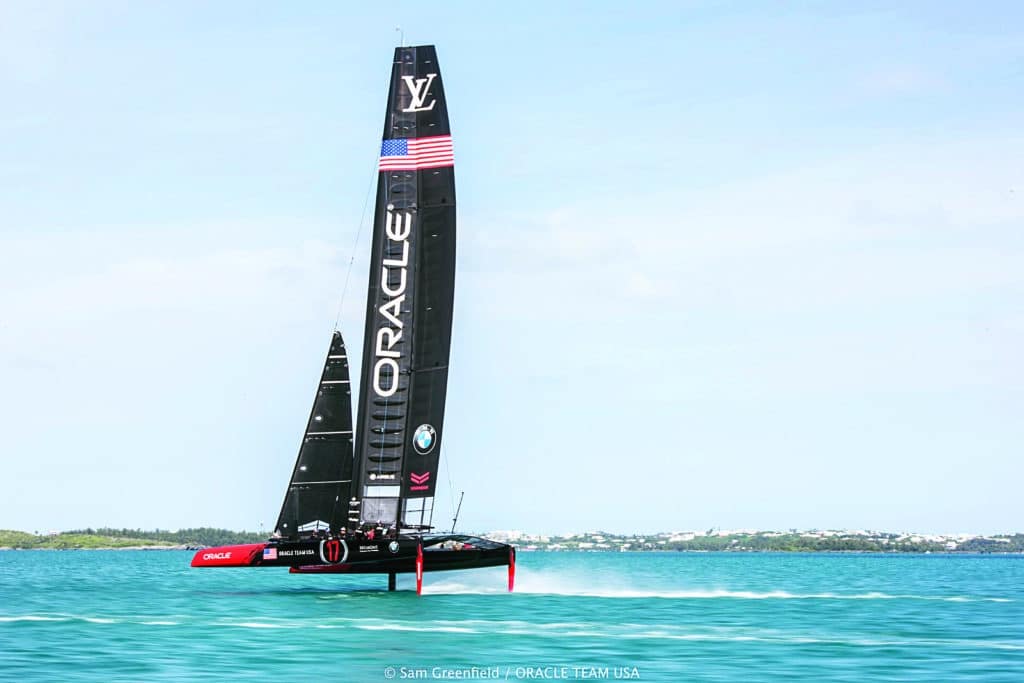
ORACLE TEAM USA training in Bermuda with the AC45S
The obsession with detail that defines the America’s Cup has intensified in the past two years with the development of the foiling crafts that will soon be revealed by the challenger and defenders. Designers and engineers assure us there will be no magic bullet, but there will still be plenty of magic in the technology that will allow teams to foil from prestart to finish. To accomplish such sustained flight, each team has been pressing its technical partners to explore every imaginable advantage, particularly in the foils. For Oracle Team USA, aerospace giant Airbus has brought more to the table than its supercomputers and engineers; it’s brought precision.
“We have up to 100,000 lines of code to program the [foil] control systems,” says Ian Burns, OTUSA’s director of performance, explaining the complex parameters required to achieve and maintain stable flight. He adds that perfect stability, however, is slow. “The more stable the foil package is, the more energy there is slowing the boat down, so having a fast control system and as smart a control system as we can get is more important.”
Speeds on these foiling cats are such that the water actually boils around the foils. The “easiest” way to reduce such cavitation is to make the foil thinner. Thinner is faster, less stable, and more likely to structurally fail. The engineers, of course, want to make the foils thicker, because foil failure can be catastrophic for the entire boat. “A 10 percent reduction in the thickness of the foil, which is a large reduction in strength,” says Burns, “can give 1 to 3 knots’ boost in top speed before you cavitate.” On the America’s Cup course’s first reach leg to Mark 1, such an advantage can be compounded.
Foil refinement, of course, is where engineers can really geek out. At their European testing facilities, Oracle and Airbus engineers have been load-testing the team’s foils. “We had a beautiful look at the board breaking using tomography,” says Burns. “Airbus owns a machine that allows us to finally do this. We can actually see inside the object and trace a failure right to the source.”
The lifting foils move a lot under load, however, flexing by as much as 1 to 1.5 feet. Some of OTUSA’s thinner boards move as much as 2 feet while sailing. “They flex a lot, and that means the mold shape we analyzed in the mold is different from what we’re sailing with,” says Burns. “[With these tests] we get a realistic model of what we’re sailing with. The second thing is taking advantage of that [flex] and making [the foil] better for when it’s deformed. That’s a difficult science, and there are opportunities there.”
Foil reliability and efficiency are one thing, but foil control is equally important. The boat’s intricate hydraulic system is the critical link between Jimmy Spithill’s trigger fingers (foil-attitude buttons are located on his steering wheels) and the foil. Every time he makes an adjustment, he’s sapping pressure from the system.
“The guys who grind put out about 300 to 400 watts continuously, and they do it for 30 minutes,” says Burns. “It’s about half a horsepower, so ultimately we have very little power, which makes it a game of efficiency — how you make it from the handle right to the actual thing you’re moving as efficiently as possible.”
Where Spithill sees the bows coming down or coming up, explains Burns, he has a reaction time of two- or three-tenths of a second, which is quick, but the time from when he realizes a change needs to happen to when the actual daggerboard gets into position has a large bearing on how far he has to adjust it and whether the boat will fly stably. OTUSA has two Airbus engineers on staff, and their main focus is reducing the delivery time. “We started at about half a second,” says Burns. “We’ve halved that time, and we hope to halve it again before the America’s Cup.”









